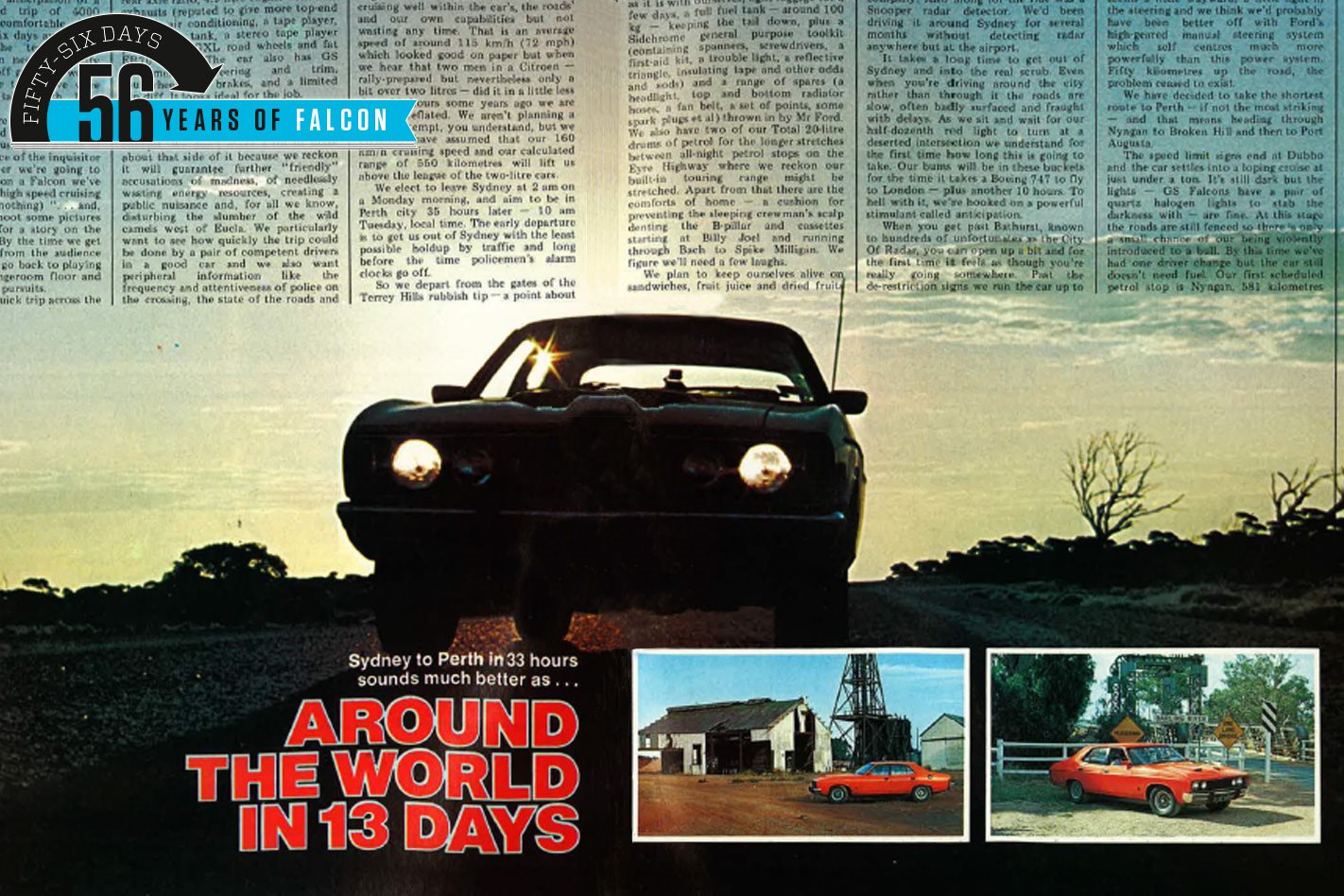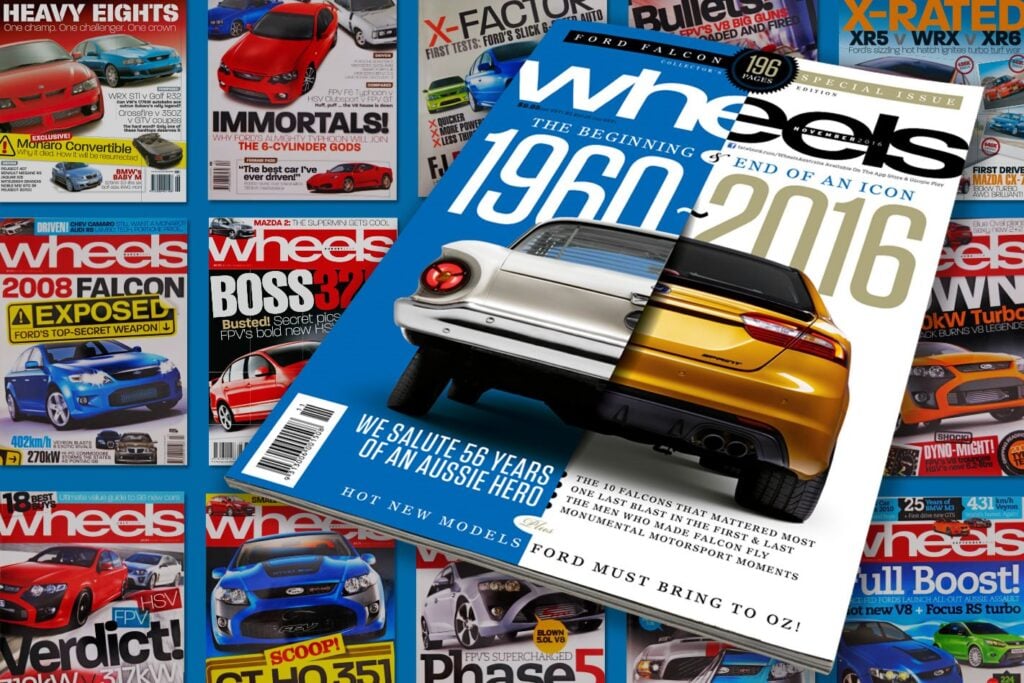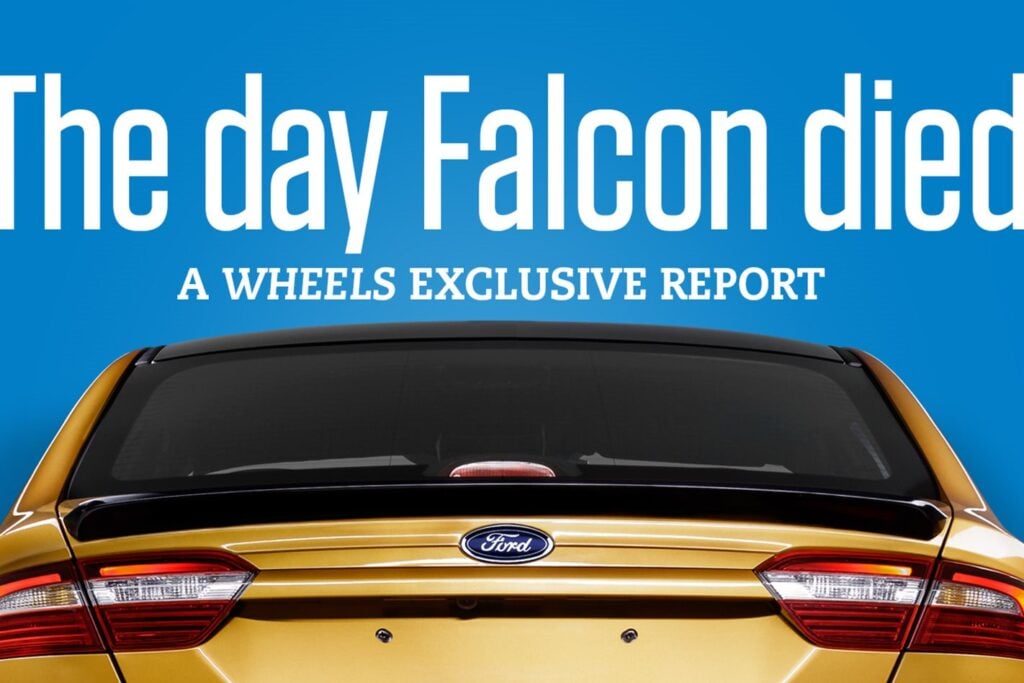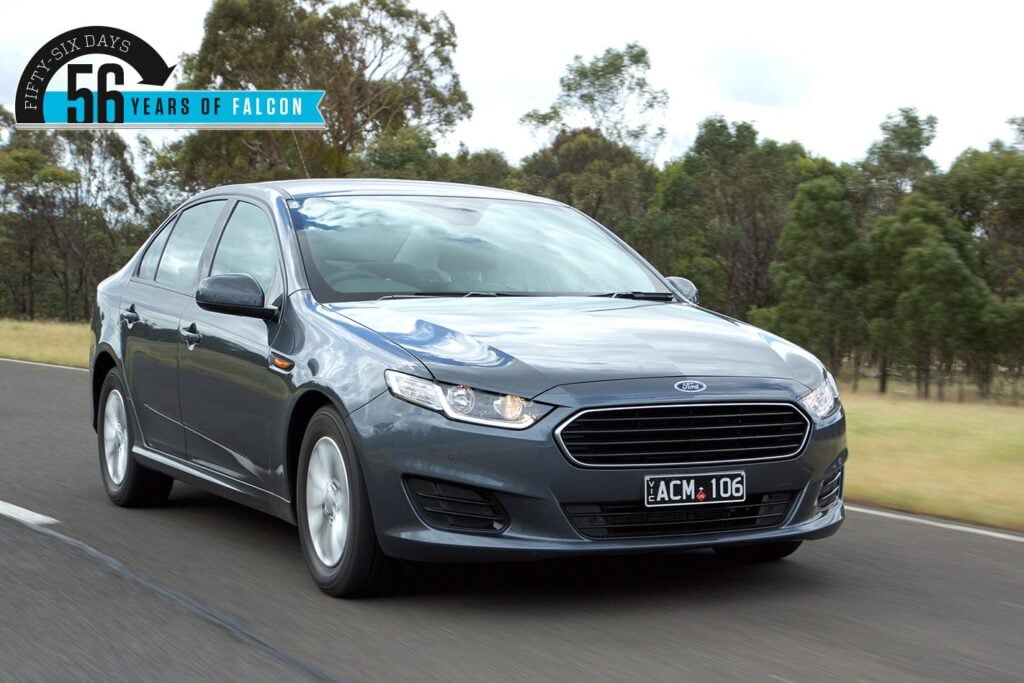First published in the July 1977 issue of Wheels magazine, Australia’s best car mag since 1953.
Sydney to Perth in 33 hours sounds much better as … Around the world in 13 days.
“YES, BUT what are you going over there for,” so·called friends ask, their faces full of puzzlement and scepticism. “What’s it in aid of?”
To us, full of the anticipation of a non-stop high speed trip of 4000 kilometres in a comfortable and long-legged car plus six days away from the phone and the tea lady with halitosis, this sudden need to justify ourselves knocks us off guard. It would be handy to say we were heading west for talks with Lang Hancock.
“Why, er … we’re going to have a look at a newly sealed part of the Eyre Highway”, we say pausing for a look of satisfaction on the face or the inquisitor (nothing) “… and, er we’re going to put some fast miles on the Falcon we’ve had optioned up for high speed cruising by Ford … ” (still nothing) ” … and, ah, we’re going to shoot some pictures and gather material for a story on the Nullarbor crossing”. By the time we get a glint of approval from the audience we’re wishing they’d go back to playing Scrabble on the loungeroom floor and leave us to our gentle pursuits.
Our plan to do a quick trip across the Nullarbor is months old, born before we took delivery of our Ford Falcon 500 GS-packed long-term test car. It is specially equipped for the job with a tall rear axle radio, 4.9-litre engine with dual exhausts (reputed to give more top-end power), air conditioning, a tape player, a 125 litre tank, a stereo tape player plus Falcon GXL road wheels and fat ER70 tyres. The car also has GS instruments steering and trim, four-wheel disc brakes, and a limited slip diff. It looks ideal for the job.
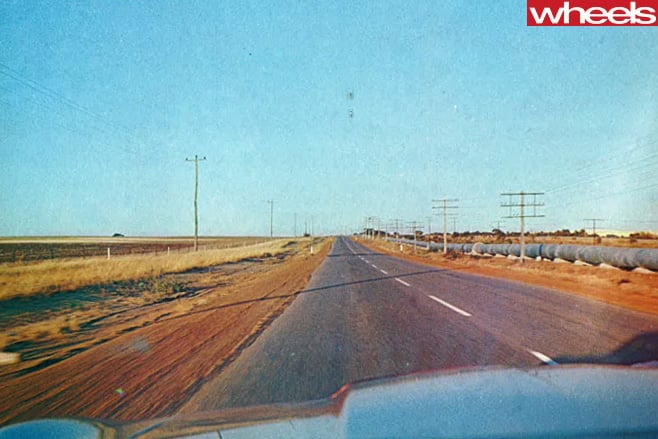
We calculate loosely that the trip ought to take around 35 hours or so, cruising well within the car’s, the roads’ and our own capabilities but not wasting any lime. That is an average speed of around 115 km/h (72 mph) which looked good on paper but when we hear that two men in a Citroen –rally-prepared but nevertheless only a bit over two litres – did it in a little less than 30 hours some years ago we are slightly deflated. We aren’t planning a record attempt, you understand, but we certainly have assumed that our 160 km/h cruising speed and our calculated range of 550 kilometres will lift us above the league of the two-litre cars.
We elect to leave Sydney at 2 am on a Monday morning, and aim to be in Perth city 35 hours later – 10 am Tuesday, local time. The early departure is to get us out of Sydney with the least possible holdup by traffic and long before the time policemen’s alarm clocks go off.
So we depart from the gates of the Terrey Hills rubbish tip – a point about equidistant from Mr Editor Robinson’s abode and mv own – at 2.04 Fomoco time and head west along the Bell’s Line towards Lithgow.
The car feels nicely balanced, loaded as it is with ourselves, light luggage for a few days, a full fuel tank – around 100 kg – keeping the tail down, plus a Sidchrome general purpose toolkit (containing spanners, screwdrivers, a first aid kit, a trouble light, a reflective triangle, insulating tape and other odds and sods) and a range of spares (a headlight, top and bottom radiator hoses, a fan belt, a set of points, some spark plugs et al) thrown in by Mr Ford.
We also have two of our Total 20-litre drums of petrol for the longer stretches between all-night petrol stops on the Eyre Highway where we reckon our built-in touring range might be stretched. Apart from that there are the comforts of home – a cushion for preventing the sleeping crewman’s scalp denting the B-pillar and cassettes starting at Billy Joel and running through Bach to Spike Milligan. We figure we’ll need a few laughs.
We plan to keep ourselves alive on sandwiches, fruit juice and dried fruit rather than throwing down the usual rot-gut or fizz and clang that o n a trip like this has polite people feeling bloated enough to burst and less-polite ones turning themselves into unpleasant company. Also along for the ride was a Snooper radar detector. We’d been driving it around Sydney for several months without detecting radar anywhere but at the airport.
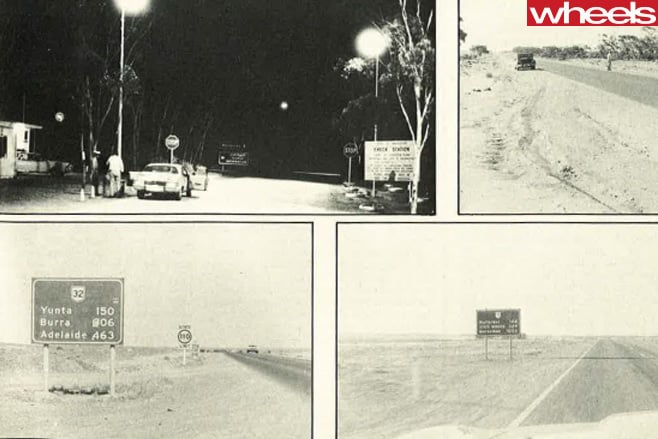
When you get past Bathurst, known to hundreds of unfortunates as the City Of Radar, you can open up a bit and for the first time it feels as though you’re really going somewhere. Past the de-restriction signs we run the car up to a 140 km/h cruise and notice as always that if it’s a while since you’ve driven these speeds it takes time to accustom yourself to the car’s responses.
Between Bathurst and Dubbo the car seems a little wayward, a little light in the steering and we think we’d probably have been better off with Ford’s high-geared manual steering system which self-centres much more powerfully than this power system.
Fifty kilometres up the road, the problem ceased to exist.
We have decided to take the shortest route to Perth – if not the most striking – and that means heading through Nyngan to Broken Hill and then to Port Augusta.
The speed limit signs end at Dubbo and the car settles into a loping cruise at just under a ton. It’s still dark but the lights – GS Falcons have a pair of quartz halogen lights to stab the darkness with – are fine. At this stage the roads are still fenced so there is only a small chance of our being violently introduced to a bull.
By this time we’ve had one driver change but the car still doesn’t need fuel. Our first scheduled petrol stop is Nyngan, 581 kilometres out and to be on schedule we must be there by seven in the morning. We’re there at 7.10 as the sun clears the horizon haze and begins to shine steadily through the rear window onto our shoulders. The car takes a mere $22.44 worth of gas giving 5.23 km/L (14.8 mpg) which is none too good because this hall been the gentlest end of the trip. We have been expected 6 km/L (about 17 mpg) on this leg.
Ten minutes’ break and we’re off towards Wilcannia where the roads are wide, straight and flat. The car’s cruise creeps up and before long we’re doing 180 km/h on the flats and 170 on the long rises with the tacho needle hovering at four grand or so. The wind noise isn’t too bad – you can converse and listen to the tapes without difficulty though there is quite a harsh rumble from the steel radials over the rougher surfaced parts. The road doesn’t have bumps that throw the car around, just higher frequency ripples to make the tyres rumble and the Snooper nod its head a bit above the dash. This trip, I observe to Mr Editor Robinson as we breast another gentle brow and look arrow-straight at the grey ribbon ahead, is turning into a tour of the straight roads of Australia.
Wilcannia is a Darling river town servicing travellers like us and the locals who run cattle on cattle stations round about. It is 398 kilometres further down the straight road and with Robbo at the wheel the Falc devours the road at 180 with us warbling “Glen Miller, Is Missing” along with the excellent ladies who were in the BBCTV show called Rock Follies. We rumble into Wilcannia with enough time to notice how clean and modestly prosperous it looks for a parched semi-desert town. The car swallows another $22 worth of Total.
We’ve averaged 176 km/h (110 mph) for the 400 kilometres but paid for it with a consumption rate of 3.59 km/L (10.1mpg). Our emotions are complicated. We wonder how this unexpectedly high consumption is going to affect our range on the long night hauls across the Great Australian Bight and whether we’re going to make it at all without asking the office for more money. On the other hand we’re elated to have averaged 176 km/h for 400 km – something you can’t do in most parts of the world any more. But that old environmental thug Robinson is a shade disappointed. He’s never got less than 10 miles per gallon out of a car and he’s disappointed to have missed out by just 0.1.
On along the straight road we go with the sun rising high behind us, lighting up the barren paddocks, some of them almost completely eaten down by stock and starting to lose their topsoil to the winds. It’s a wide, parched bowl of a place late in summer and we seem almost motionless in it at our 160 km/h cruise. It’s so grand that when you say “It’s a big country, mate” the comment seems to be charged with a special meaning. You clean forget that it’s a comment uttered probably a dozen times a day by other travellers on the same spot.
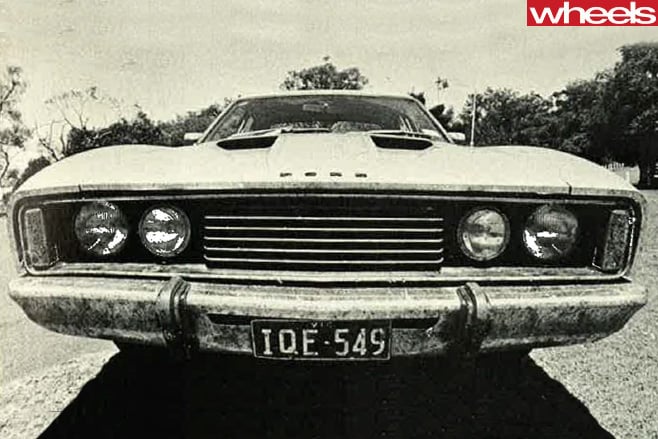
Broken Hill, it happens, is where I was born. I don’t often mention this fact because it leads to all sorts of inane questions at barbecues. “Is it as bad as they say?”, is the most commonly asked question, basically because a succession of TV documentary teams have made the place a kind of junior totalitarian state. Businessmen in Broken Hill will tell you that there is considerably less industrial disturbance than in the ” peaceful ” capital cities.
As we get closer to the Hill we run into the hills and folds and creeks surrounding the Barrier Range around the city. We pass the Mount Gipps pub, one of the Sunday watering holes 40 kilometres out of town, and I tell Robbo that over the next brow is a railway bridge which I used to play on as a kid and once had to jump off to avoid a goods train which appeared at one end.
But the bridge is not there. I feel like a drongo. It WAS here 20 years ago. I remember. I see a certain scepticism in the eyes of Cap’n Robbo. Only later do I discover that they’ve shifted the bloody railway line …
We take time out for a quick lap around Broken Hill – a fairly large (28-30,000 people) but unlovely city divided into two by a silver/lead/zinc lode of formidable proportions running through its middle. The easiest ore has been extracted now, and the three big companies left there are having to go deeper for what is left. But there’s plenty of life there yet. I show Mr Editor Robinson where I was born and where I went to school and where I had a fight with a kid who once pinched my bicycle and he generously pretends to be interested. It takes 10 minutes and we don’t get out of the car.
Now we’re onto perhaps the most treacherous piece of road on the entire Sydney to Perth trip. It’s 50 kilometres of winding road through the Thackaringa Hills out towards the town of Cockburn on the NSW /SA border. The road is quite well surfaced (though none-too-wide) but it was laid at least 20 years ago and its engineering is poor. There are bends hidden over crests; and a diabolical series of dips which result from the road-builders being too stretched for cash to build bridges across the creeks. This piece of road has killed people and damaged a lot of cars – and the worst part of it is that there is little warning of the severity of the dips.
Many people travelling at quite restrained speeds must have been surprised along here. It’s a pleasure to be past it, both for the pits of our stomachs and our average speed.
Across the SA border the road is transformed into a wide, smooth, straight aggregate surface which juts up at the horizon like a giant rifle sight. The State limit of 110 km/h could be safely doubled in the right car.
We press on down the fenced, deserted road through the first of a collection of fruit fly inspection points scattered across Australia and down the main road from Broken Hill to Adelaide. The car is getting low on fuel, even though we’ve slowed down a bit it seems pretty unlikely that we’ll get anywhere near our next fuel stop, Peterborough. But the old orange bitch surprises us. The fuel gauge needle goes into the red, it goes hard onto the “E” mark and eventually there’s pace between that mark and the needle before car falters a couple of kilometres before the shabby little SA town of Oodla Wirra. We use the old truckie’s technique of stopping immediately there’s a sign of fuel starvation so that there’s enough fuel left in the induction system to kick it over after we’ve put in more fuel.
We drive to Peterborough, 30 kilometres along, and watch a service station owner smile as he pumps $20 worth of petrol into the Falc. His wife stops work behind the counter to “watch them tumblers roll”. Wilcannia to Peterborough is a shade more economical. We’ve registered a mighty 3.9 km/L (10.9 mpg) which is better but it doesn’t exactly make us happy.
Wilcnnnia to Peterborough is only 490-odd kilometres by the odo and the Falc couldn’t make it on a tankful at its natural cruise. Tonight our longest hop is supposed to be 707 kilometres, Eucla to Norseman …
After Peterborough we head for Port Augusta where smoke belches from tall chimneys and a myriad of prosperous-looking mothers compete for parking spaces in the main drag. We fill up again and find that running a bit slower – nothing over an indicated ton – gives 4. 2 km/L (nearly 12 mpg). Hell, says Captain Robbo, the old tart’s getting economical . ..

It’s out of the question for trucks and larger caravans and even small vans and long cars can strike problems. To make matters worse there’s a large monument to the guys who found the pass first in the 1800s – slap in the middle of the pass – and there are large rubber lockup marks either s ide of it where tourists have stopped to read and very nearly caused an accident.
Out of Port Augusta we’re supposed to head for Iron Knob and Kimba but the navigator – I refuse to name him but it wasn’t Robinson – puts us on the wrong road and we finish up in Whyalla and have to take a corrugated and frequently rutted backroad to get back on Route One. It costs us about 60 kilometres and about 40 minutes.
Mr Editor Robinson demonstrates iron control over his temper as he flails his elbows to keep the Falc straight on the dirt at 110-130 km/h. Presently I come out of my cringe and offer him a dried apricot. Much later we find that on this fairly violent section we have torn a lug off one of our Uniroyal steels. Much later is actually at Kalgoorlie on the way back where we also discover that the fine men who serviced the car for us in Sydney forgot to put the jack back in …
Some way on we stop to put fuel into the Falc from our drums and as we pull off onto the verge the firmness of it proves to be only a crust and the left hand side wheels sink deep into sand. We struggle to get the car out and with the help of the slippery diff and myself pushing against the heel angle of the car we finally ease it out. We’re recovering ourselves when a little Daihatsu 4WD, travelling fast at 80 km/h re-passes us. We’d blown his doorhandles off at 160 a few minutes before. Could have been embarrassing to have had to ask for a tow …
At Ceduna we pause to shoot some pix with the water, jetty and fishing boats in the background. In between clicks of his shutter Captain Robinson explains to a persistent Aborigine that he can’t possibly spare 50c as we’ll probably need every sheckel to keep the big orange bitch in fuel. This is not a fob-off because even with slightly slower cruising (around 140-150 km/h) the Falc still won’t give better than 4.8 km/L (13.4 mpg) which is hardly brilliant.
Next stop is Eucla over the WA border and 520 kilometres away. We drive off with the setting sun becoming more and more of a problem to the driver. But as dusk approaches and the sinking sun cuts down forward visibility we are forced to cut back our cruise to 120-130 and it hurts. It really hurts.
The car is running on less than half throttle and begging for its freedom – not obtrusively but with a kind of well-exercised 7000 kilometre-old sharpness which develops from energetic treatment. The road is obviously good enough for 240 km/h in the right light conditions and it’s almost a privation to have to slow merely because of poor visibility. Naturally in your Morris Marina you’d be crazy to contemplate touching 120-130 km/h any of the way across Australia but in this car high speed is as safe as the Wales.
We drive on. We drive on as though we were born to do nothing but drive on. We aren’t bored – haven’t been at all yet, but we are starting to notice that we’ve been in the car for a long time.
When we stop to lay the dust or throw in extra fuel from the drums we are carrying we notice the effects of nearly a day’s inactivity in the car. We have no aches from orthopaedic lacks in the car’s seats – they’re still good to sit in – but we are getting stiff from lack of movement.
It is a blessed relief when the sun goes down. The horizon is still bright and it’s hard to spot the ‘roos and wombats and occasional emus that the signs periodically warn us about, but at least we aren’t dazzled. By the time the sun disappears we’ve crossed the Nullarbor, at least the small part of the Nullarbor crossed by the road. The newly sealed SA part of the road goes closer to the coastline than the old goat track did and so you’re only really on the Nullarbor for about half an hour these days. Along the coast route there are now signs – white painted camera symbols on blue backgrounds – which indicate areas where tourists may pull off and photograph the ragged Bight cliff , some of them a hundreed metres high, from selected vantage points.
The facilities for travellers along the new road are surprisingly good. There are frequent signposts (at least they’re frequent at a 160 km/h cruise) telling the traveller his distance from the nearest settlement, together with information about the services offered there (towing, food, campsites, motel, medical help, car repairs, petrol). There are water tanks scattered across the route and camping areas provided here and there. There are also signs that indicate the whereabouts of emergency telephones. It’s still a long drive but it’s certainly not the little piece of Burke and Wills it used to be . ..

There are dead animals on the side of the road to reinforce the warning of the signs. We see heaps of ‘roos – particularly between Ceduna and Eucla, but nary a wombat or a camel. But we hit two rabbits and a fox.
At 2 am Tuesday (Sydney time) we calculate that we have covered 3223 miles in 24 hours at an average speed of 134 km/h (83.9 mph) and we’re still going well.
Not long after that we start to run right out of energy. From two-hourly intervals we’re forced to cut back our driving stints to an hour and eventually to about 30 minutes to stay awake. We begin to slow down and get exceedingly cautious about animals on the road – all the more because we don’t seem to be seeing as many as before. Tiredness is approaching and the help of cold air from the vents and flat-chat taped music helps but we feel that neither of us is going to be in a fit condition to drive for much longer.
But we reel in all the traveller’s fuel stops gradually. Madura (situated in a pass at the edge of the Hampton Tablelands), Cocklebiddy, Caiguna and Balladonia (with its olde English stone walls and homestead ruin) all pass in the darkness, though slowly because we’re stopping more (and enjoying it less).
Finally out of the darkness we spot the lights of Norseman and it feels as if we’ve arrived at the outskirts of Perth. Our slowness on that leg is just as well because we’ve averaged an astonishing 7.455 km/L (21 mpg). Just shows what driving when you’re dead beat can do.
We’re surprised to find that our past few hours of sluggishness hasn’t hurt our average speed much because we’ve been storing up time for close to 24 hours beforehand and we’re still averaging better than 125 km/h. It does the hearts good. We question the pump jockey at Norseman (whose brother has a GS Falc just like ours except it’s a 5.7 litre) about camels on the road ahead.
“Can’t tell”, he says, “sometimes ya don’t see a single one between here and Southern Cross; other times ya gotta drive in and out the bastards”.
We drive on, not seeing a single camel to drive in and out of but spotting a few experienced kangaroos which high-tail it into the low scrub as we go by. We don’t seem to get any worse though it is starting to be a pretty big task to enjoy the trip. But it’s hardly worth stopping. We can both steer a straight course still and anyway, sunrise is only an hour or two away.
Eventually, we reel in Coolgardie and then Southern Cross and the sun comes up and we’re both filled with the vigor of a pair of kids. We’ve been fearing this night but now we’ve beaten the bastard; we’re four-fifths of the way to Perth and we’ve got daylight and a healthy car to complete the trip. Everything is coming right.
Except one thing. We notice in daylight the lines painted across the road which we’ve been told are for an airborne police spotter aircraft which times a car over a set distance and radios to ground police who pull the car in. It is a Tuesday morning, early, and we’ve been told that the “bear in the air” only operates on weekends but it’s still a little unnerving to be crossing these cream-colored dotted lines all the time particularly at speeds perhaps a bit higher than the lawmen would like. So far there’s been no problem with police anywhere. The roads we’ve covered in NSW have been subject only to a prima facie limit, the ones in SA have been so deserted and remote as to be safe at practically any speed and so far we’ve traversed the WA section at reduced speed in unlikely hours.
Actually the road traffic control in WA isn’t handled by police at all but by officers of the RTA (Road Traffic Authority) using white pursuit cars with sirens and blue lights on the roof. They also have “unmarked” police cars but most of those have WA personalised plates in gold and blue starting with the prefix “RTA “. A greater threat than spotter planes (at least reports the RTA was waiting for a State grant to buy its own aircraft) is the hand-held radar gun as used by US Police forces. But our Snooper is to be silent from Sydney to Perth and all the way back.
Civilisation starts again at Menedin, about 260 kilometres from Perth. The paddocks get fences and there is evidence of large scale scrub clearance and crop growing. The suspense is all over. We’re going to make it – and about two hours before we expected to.
The country gets more and more lush as we approach Perth with vines and crops and trees and greenery getting thicker until we drive up and over some wooded hills and into Perth proper.
As always at the end of a long haul it’s an anti-climax. It’s a neat city – in fact Captain Robinson on my left is already romancing about it having a “feel” of its own: l can’t feel a thing except that my body is divorced from my head. The Coke signs and the MFA banners and the traffic lights are the same here as they are in Sydney. We’ve just driven the equivalent distance of Paris to Moscow and we’re still in the same country among the same people and the same white Holdens. A tenth of the way ’round the world we’ve driven, and we might as well have gone to the corner store and back for all the cultural differences there are. Still, there won’t be too many language problems …

We amble into Perth among the morning “peak hour’; traffic. As we drive across the Swan River, Robbo calculates that we’ve been driving for 32 hours and 58 minutes and the odo imparts the info that it’s 4041 kilometres from the Terrey Hills tip to the Swan River. We’ve averaged 123.9 km/h (77.4 mph) including all stops and 45 minutes lost in going to Whyalla by mistake. But who gives a damn? I want to go to bed.
FALCON XC options maketh the proper car
FORD LIKES to believe that its XC Falcon is as much at home carting the kids to school as it is in the shadow of Ayers Rock. The industry calls the product of this philosophy the 100 percentile Aussie car, and it is one of the reasons why local cars have been so successfully assaulted by the Japanese in recent years.
The Japanese have always understood that to be popular, in Australia, you don’t need to build cars that are designed to match all the conditions a driver might meet if he drives around Australia once a month. Since the vast majority of people live in the eastern cities and few venture off the main roads, even if they do happen to wander away from the confines of the suburban speed limits, there really is little need to build big rugged, traditional, family-sized sedans.
For Ford and, perhaps to an even greater extent, GMH, the building of a car that is capable of coping with the outback conditions has always been a matter of conscience and it is one of the truisms (myths, perhaps?) of the local car scene that European and Japanese cars can’t take the strains imposed back of Bourke, even if that legend is about to be challenged from – of all places the new breed at Fishermen’s Bend.
If the Japanese have never bothered to build cars to match the conditions, Ford has tried hard to create the popular impression that the Falcon really belongs in a class above the other local stuff as a road machine and can (indeed should) be compared to the hot-shoe, long-legged Europeans. It shouldn’t go unnoticed here, that the Falcon GT would have been 10 years old in March if it had lived another nine months.
So when Ford’s senior executives expressed disappointment at the reception the XC received from WHEELS at the time of its introduction and suggested we should build up a Falcon – any Falcon – from the options list two selfish thoughts raced through the editor’s mind. Here was our chance to build a car specifically for our long planned trip from Sydney to Perth but, equally, we could discover once and for all time if a Falcon could be made that would turn the daily commuter grind into a pleasure. In other words it had to be a desirable hack and a fine touring car. And with somebody else footing the bill…
Clearly, with our objectives we could have gone either the GXL route (after all Ford claims this is the local car with a European theme) and fitted it with the biggest of the VS engines and had a GT in all but name, or we could elect a 500 and have a thoroughly enjoyable time wandering through the options lists to create an interesting car. To keep the price down (?) to a reasonable level we choose the 500, although it was not without pangs of indecision. With one or two minor exceptions, however, we have never regretted choosing the base car, perhaps because, by the time we had finished with the options lists we had virtually built a GXL anyway.

We made the right decision and have enjoyed that marvellously satisfying feeling of power that comes, not from dropping smokies, but from dribbling around behind a bent eight on throttle openings owners of small capacity fours would never believe and never having to use more than 1800 rpm through the gears and still be able to beat all but the most determined opposition at the traffic lights.
We agonised over the choice of gearbox. After preaching the advantages of an automatic in suburban use it was almost mandatory that we choose the auto. Instead we turned traitor and opted for the four speeder. Over 15,000 km later we’re happy with our decision.
The V8 is tractable and smooth enough to be driven as a two gear car in traffic if you’re fed up with changing cogs and it is quite the normal practice to go one/two/four, and yet all four ratios can be used to advantage if you want to run with the wind on your favorite piece of switchback. We also figured that on the run to Perth a manual might be more economical, and have more performance, than an auto. That was the theory of it.
The damage for a 4. 9 500 with four speed is (was) $6639 and we had only started down the options list. Ford’s engineers claim the addition of twin exhausts gives a measurable increase in power and improves engine efficiency so the $105 for twin pipes seems well spent. Four wheel disc brakes are standard on the GXL and give the Falcon a braking ability unobtainable on any other local car. At $193 they are not cheap but very worthwhile. We have long criticised Ford’s low geared and numb and heavy (with the fat ER70H14 Steelflex Olympic radials – $80 over the standard radials) manual steering and opted for power, although we knew it would be too light for high speed work and required some adjustment by a driver accustomed to even direct manual steering.
Of course we needed air conditioning ($633), not only for The Big Trip where it became the major factor in reducing driver fatigue to a minimum, but also for regular use around Sydney during a humid summer. For entertainment we ordered an AM/FM radio ($282) – has anybody else noticed just how good Australian radio has become over the past couple of years? – and a stereo cassette for the times when we want to choose the music (another $173).
We also ordered intermittent wipers ($24); a rally pack for the instruments and driving lights ($322); tinted laminated windscreen ($90) and every car should have one; long range, 125 litre (27.5 gallon) petrol tank which was essential for the Perth run, even if it meant the spare wheel ended up on the floor of the boot and not inside the well of the fuel tank ($34); sports handling suspension ( $97) for the rear anti-roll bar and the stiffened suspension; cloth trim ($35); rear inertia reel seat belts ($33); limited slip differential ($82); and a remote control right hand exterior mirror ($21). And because we liked them so much our 500 also came with the GXL alloy wheels although these are not a regular production option. It sometimes pays to have contacts in the industry.
All those options produce the very grand total of $9073. At which point we started to look through the new car price list at the back of WHEELS to see just what sort of proper car we could buy for nine grand that could tackle the same tasks we had in mind with some chance of success. It was a frustrating search. The Alfetta sedan perhaps; just maybe a Beta sedan; certainly a Peugeot 504; not really a Triumph 2500TC; or a Volvo 244 and not a Volkswagen Passat. All the rest are either too expensive or simply not up to it.
And at the end of the Perth trip we must admit to having decided that none of these cars could have logged the same average speeds, with the possible exception of the Alfetta and Beta. But even with their superior fuel consumption they would have been let down by their small petrol tanks. We also wondered about the ability of European air conditioning units to cope with local conditions.
All of this ignores the 308 HX Holden and the 265 Charger. But until the HX gets Joe Whitesell’s Radial Tuned Suspension it is not in the hunt and neither the Holden nor the Charger have those very necessary optional long range tanks.
We collected the Falcon in Melbourne one Friday afternoon, about six weeks after placing the order, happy with our choice of orange after seeing the car in the flesh although the doeskin, with houndstooth, upholstery seemed a little overpowering. We noted with interest that the driver’s seat was mounted straight onto the seat runners, in contrast to the XC test cars which had nylon bushes to raise the cushion and improve visibility at the expense of some headroom. We would have preferred it higher so one of the changes we requested early on was to have the seat raised and moved back to the second of the runner mounting points for more front seat legroom. Both moves were immediately noticeable to anyone coming back to the car, which again proves one of our pet theories that minor changes to seating height can make an enormous difference to driving comfort.
Running-in the Falcon – it had 137 km on the odometer when we picked it up – was made easy by the heavily policed Victorian speed limit of 100 km/h on the Hume Highway. With the recommended 2.92 final drive ratio, the Falcon runs to 41 km/h (25.5 mph) per 1000 rpm so the crank is turning over at less than 2500 rpm at the legal limit which makes the old idea of running-in virtually obsolete.
The 6.3 km/L (17.8 mpg) to Albury was about what we expected from a tight engine. Between Albury and Goulburn the Falcon returned 5. 7 km/L (16.0 mpg) which reflects the change in character of the road that always has us running quicker in NSW.
By the time we reached Sydney we had begun to like the Falcon, even if it did seem rather characterless, if not quite bland in the way a fleet operator’s 500 six with auto is bland. Nothing fell off and only a squeak from the A-pillar, and driving lights which needed adjustment, gave cause for complaint.
We liked the seemingly endless torque of the V8 and the general ease with which it can be driven but found the dashboard and control layout messy. It was obvious the Falcon still has all the much-vaunted virtues that local cars have been strong on since the 48-215. Our XC has now become the kind of car you can trust, not so much because it starts first time – which it doesn’t when the engine goes out of tune, which it does occasionally – but rather in its ability to get you out of trouble on the road. Of course the back axle can be made to get out of step and clatter around and hop sideways over bumps but it is quickly caught and controlled and the car has reserves of braking and even roadholding that still comes as a surprise. It goes around corners and point-to-point can set times even Europe’s best two-litre sedans must be wrung out to achieve. And all in relative comfort and quiet.
Mister Cropley will have entertained you with the story of The Big Trip but it is worth repeating that the Falcon is now running better than ever and we have become fond of its strengths and tend to rationalise its weaknesses, which are few within the fundamental limitations of the essentially late ’60s design.
The Falcon is the best of the present homegrown cars in both base form and the optioned up variety. Whether that remains the status quo after Whitesell has finished with the HX only time and plenty of kilometres will tell, but we’ll be sorry to see this Falc go out of our lives.
Now, if only we could reduce the weight by 225 kg (500 lbs) and improve its aerodynamics for better fuel consumption and cut its turning circle by a metre and increase the glass areas and do something about the rear axle location we’d really have a world beater … maybe that’s what the XD will be all about.
Check out Wheels Archive online now for other great Ford Falcon features and more from decades past!
Simply log in here using your existing MagShop account or create a FREE account and select this article from the homepage.
Don’t have a MagShop account?

Have a MagShop account?


